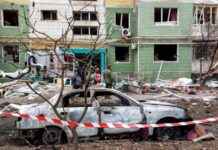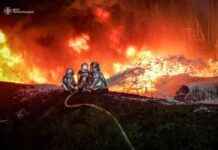The Thap Lan National Park in Nakhon Ratchasima province is currently battling a devastating wildfire that has ravaged over 500 rai of forest land. The blaze, which began on Friday, has posed significant challenges to firefighting efforts, despite the continuous collaboration between volunteers, firefighters, and forest officials. The fire has been contained in some areas on Kok Chang mountain, but the difficult terrain, characterized by steep cliffs, has hindered complete extinguishing of the flames.
Concerns were raised earlier about the possibility of a fire in the region, and these fears were confirmed when assessments on Saturday revealed that approximately 300 to 400 rai of forest, primarily dry vegetation, had already been devoured by the fire. Prawatsart Chanthep, the head of Thap Lan National Park, highlighted the existence of prior warnings regarding the fire risk in the area.
Initial investigations have pointed towards a deliberate act of arson, with evidence suggesting that the wildfire was set intentionally. This suspicion was strengthened by an earlier unsuccessful attempt to start a fire on Thursday, which had already destroyed 200 rai of land just a kilometer away from the current site. Mr. Prawatsart indicated that illegal loggers are under scrutiny as potential suspects in the case.
Thap Lan National Park, spanning across 1.4 million rai in Nakhon Ratchasima and Prachin Buri, has been a focal point for authorities in light of the escalating situation. In response to the crisis, Nakhon Ratchasima authorities announced on Monday the immediate closure of the national park for a three-month period. This decision aims to facilitate the work of rangers and other agencies in combating forest fires and protecting the park’s natural assets.
The Ongoing Battle Against Wildfires
The wildfire situation at Thap Lan National Park underscores the critical importance of effective firefighting strategies in mitigating environmental damage and preserving vital ecosystems. The collaboration between various stakeholders, including volunteers, firefighters, and forest officials, exemplifies the collective effort required to combat such emergencies. However, the challenging topography of the region has posed obstacles to containment efforts, necessitating innovative approaches to address the wildfire effectively.
Protecting Our Natural Heritage
The deliberate nature of the wildfire at Thap Lan National Park raises concerns about the impact of human activities on delicate ecosystems. Illegal logging, in particular, has been identified as a potential trigger for the fire, highlighting the urgent need for stringent measures to safeguard protected areas. The closure of the national park underscores the commitment of authorities to prioritize environmental conservation and prevent future incidents of arson.
Efforts to combat the wildfire at Thap Lan National Park serve as a poignant reminder of the fragility of our natural environment and the pressing need for sustainable conservation practices. As we navigate the challenges posed by climate change and human encroachment, preserving our natural heritage remains a collective responsibility that demands unwavering dedication and vigilance.



















